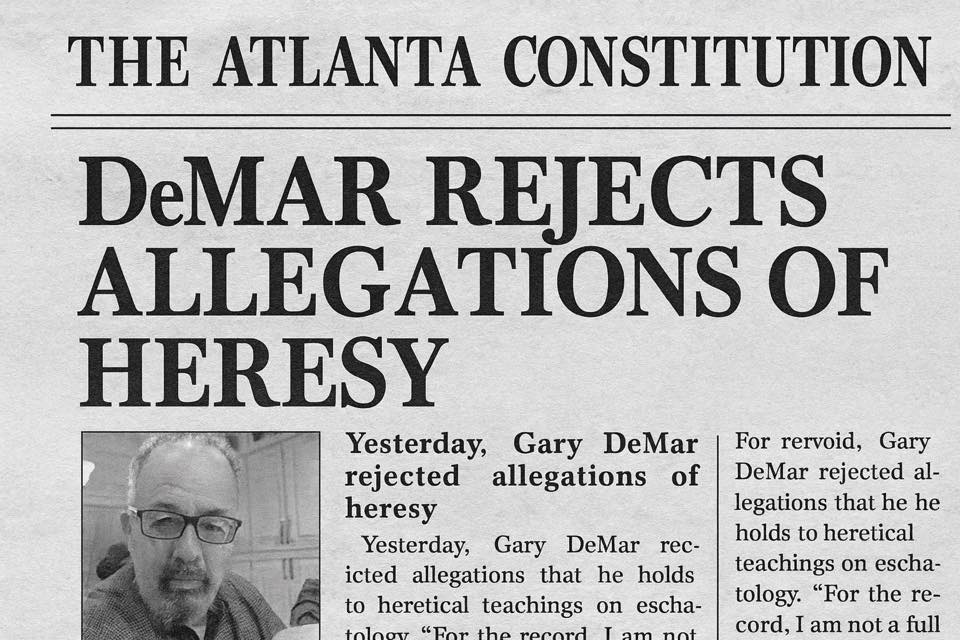|
A Book Published in 1993 by Canon Press,
P.O. Box 8741,
Moscow, Idaho 83843
Click Here for Free Online .PDF of Book
Full Review of And It Came To Pass
The Great Gary DeMar Controvery (Archive)
Gary DeMar Controversy Playlist (YouTube)
Tim Martin Unpacks the Gary DeMar Controversy on YouTube: Part 1
The Gary DeMar Controversy & How Doug Wilson and Canon Press Teach Covenant Creation - the Quiet Part
The Sequel! Tim Martin Offers an Update and Analysis on YouTube: Part 2
Update (2024) The Gary DeMar Controversy: Canon Press Deplatforms Canon Press!
DeMar v. Wilson Debate/Discussion (November 3, 2025) Videos Playlist on YouTube:
Gary DeMar Content and Wilson Debate Playlist
The modern revival of preterism represents an interesting and important paradigm shift in eschatology... I commend this volume as a fine introduction to some of the most fascinating and important elements of preterist interpretation and hope that it will stimulate serious, scholarly research and discussion into the questions that remain in doubt.
Foreword by R.C. Sproul, p. vii.
First, the authors are committed to the principle of sola et tota Scriptura, that is, only Scripture and all of Scripture. Only Scripture, and Scripture in its entirety, is authoritative in matters of belief and practice.
Introduction by T.J. Morin, p. 2.
In order for the new heavens and new earth to be established, the old order must first pass away. Two questions immediately present themselves. What is meant by the phrase "heavens and earth"? When will (or did) the transition take place?
With regard to the first question, we must immediately rule out a reference to the physical cosmos... (p. 27)
So then, the heavens and earth are a figure for the kingdoms of heaven and earth. The new heavens and the new earth are a figure for the glorious and ever-increasing reign of our Lord Jesus Christ.
"Biblical Pictures of the New Cosmos" by Douglas Wilson, p. 29.
“The phrase [heaven and earth] also occurs in Revelation 21:1: ‘And I saw a new heaven and a new earth, for the first heaven and the first earth had passed away. Also there was no more sea’….
If we take the statements at face value, then we should conclude the the first heaven and the first earth passed away and was replaced by the glorious reign of the Lord Jesus Christ.”
"Biblical Pictures of the New Cosmos" by Douglas Wilson, p. 33.
Why does eschatology matter?...
The biblical pattern is one of doctrine received, understood, then applied. Those who hurry off to application before they have understood their orders are a nuisance to their master. "He who sends a message by the hand of a fool cuts off his own feet and drinks violence" (Proverbs 26:6). There have been many fool's errands in the history of Christendom which could have been prevented with a little careful exegesis.
"Who Cares?" by Douglas Wilson, p. 129, 132.
The topic of this symposium is preterism, and the issue with which this paper deals is the timing of the fulfillment of the events described in Matthew 24 and the other apocalyptic accounts in the gospels. The thesis is that a proper reading of Matthew 24, in the context of the rest of Scripture, requires the conclusion that the events there prophesied by Jesus Christ came to pass shortly after His death and resurrection, and within the lifetime of His contemporaries. In other words, the Bible teaches that the doctrines of the end of the age, the great tribulation, and the Lord's Second Coming are not matters of eschatology, but matters of history...
It is important that this gap in our knowledge be filled in. The misinterpretation of Scripture on this point is not a harmless error, for it leads to a false assumption: that the church of today stands in the same relation to the Lord's return as did the church at the time of the apostles.
"Apocalypse Then: The Historical Doctrines of Matthew 24" by Gregory C. Dickison, p, 63, 76.
John's gospel teaches us that the disciples, even after witnessing Christ's resurrection, did not understand the Old Testament prophecy regarding His resurrection. The passing of the prophesied event did not clear up the confusion about the prophecy. Consider also that the Incarnation, one of the most thoroughly prophesied events in history. Volumes have been written on the many Old Testament predictions of Christ's coming. But when Christ did come, very few people knew that biblical prophecy had been fulfilled. Those who were the most familiar with the Scriptures were expecially misled about the coming of the Messiah. When their precious Messiah came, they crucified Him.
It is certainly true that the meaning of Old Testament prophecies were made more clear after Christ's coming. The reason for this is not simply that the event came, but that further revelation came with it. This is the implication of 1 Peter 1:10-12, where we read that the prophets of old looked forward to the sufferings of Christ. Long ago they understood that Christ would suffer, but the time and the circumstances was not revealed until the first century. Clarification of the Old Testament prophet's message came in the first century only because new revelation came at that time.
In the case of the Olivet Discourse and John's Apocalypse, the fulfillment of these prophecies was not accompanied by further revelation. Unless further divine revelation comes, we won't ever be able to understand Matthew 24 or Revelation any better than we can today. The mere passing of time does not affect our understanding of biblical prophecy.
"A Reasonable Look at Revelation" by Chris Schlect, pp. 82-83.

Gentile Salvation in the Old Covenant by Douglas Wilson
The Promised Land of Lot by Tim Martin
The Second Coming: Judgement on the Nations by Spencer Smith
Complete Archive of the Great Gary DeMar Controversy of 2023
Gary DeMar Controvesy Video Playlist (Youtube)

back to Book Reviews

|






